Abstract
We propose an optical technique to load neutral atoms in quantum adsorption states of a dielectric surface. Considering a realistic atom–surface potential well, we show that free cold lithium atoms approaching a LiF surface may be transferred to a surface bound state of the first excited atomic state. We also discuss schemes to populate adsorption energy levels of the atomic electronic ground state, and we find that spontaneous mechanisms transfer more than 90% of the excited adsorbed atoms into vibrational levels of the fundamental adsorption potential. The lifetime of the resulting two-dimensional waveguide is calculated, considering the adatoms’ interaction with the crystal phonons.
Similar content being viewed by others
References
Fujita J, Shimizu F (2002) Mater. Sci. Eng. B 96:159
Tanaka K (1999) Thin Solid Films 341:120
Rosei F (2004) J. Phys. Condens. Matter 16:S1373
Farías D, Rieder K-H (1998) Rep. Prog. Phys. 61:1575
Jardine AP, Dworski S, Fouquet P, Alexandrowicz G, Riley DJ, Lee GYH, Ellis J, Allison W (2004) Science 304:1790
Treutlein P et al. (2004) Phys. Rev. Lett. 92:203005
McGuirk JM, Harber DM, Obrecht JM, Cornell EA (2004) Phys. Rev. A 69:062905
Desbiolles P, Dalibard J (1996) Opt. Commun. 132:540
Hinds EA, Boshier MG, Hughes IG (1998) Phys. Rev. Lett. 80:645
Lima EG et al. (2000) Phys. Rev. A 62:013410
Passerat de Silans T, Farias B, Oriá M, Chevrollier M (2004) in XIX International Conference on Atomic Physics (ICAP), p 188
Perturbation theory for the higher-order terms of the surface potential (1) gives relative corrections of the order of 10-2 for the adsorption energies. Then, such a refinement is worthless if one considers the actual lack of experimental data or precise calculations for this atom–surface interaction
Ashcroft NW, Mermin ND (1976) Solid State Physics. Saunders College, Philadelphia, p 368
Various potential shapes have been considered to describe the surface potential for neutral atoms, such as, for example, 12-3, 9-3, Morse; see for instance Ref. [19]
Metcalf HJ, van der Straten P (1999) Laser Cooling and Trapping. Springer, New York
Bouchiat MA et al. (1999) Appl. Phys. B 68:1109
Yan Z-C, Dalgarno A, Babb JF (1997) Phys. Rev. A 55:2882
Stephens M, Rhodes R, Wieman C (1994) J. Appl. Phys. 76:3479
Hoinkes H (1980) Rev. Mod. Phys. 52:933
Clementi E, Raimondi DL, Reinhardt WP (1967) J. Chem. Phys. 47:1300
Magnier S, Aubert-Frécon M (2002) J. Quantum Spectros. Radiat. Transfer 75:121
Chevrollier M et al. (1997) Opt. Commun. 136:22
Mackie M, Javanainen J (1999) Phys. Rev. A 60:3174
The Morse potential used in our calculations reproduces these behaviors because it was adjusted to the physical potential (see Sect. 2)
Vardi A, Abrashkevich D, Frishman E, Shapiro M (1997) J. Chem. Phys. 107:6166
Passerat de Silans T, Oriá M, Chevrollier M, to be published
van Kessel O et al. (1992) Nucl. Instrum. Methods Phys. Res. B 64:593
Henkel C, Pötting S, Wilkens M (1999) Appl. Phys. B 69:379
In Ref. [7], ultra-cold atoms from a Bose–Einstein condensate probe surface-based electric fields, but the authors used a glass surface as the only dielectric material. See also Lin Y-J, Teper I, Chin C, Vuletic V, Phys. Rev. Lett. 92:050404 (2004)
Gortel ZW, Kreuzer HJ, Teshima R (1980) Phys. Rev. B 22:5655
Vargas MC, Mochán WL (1998) Surf. Sci. 409:130
Vollbrecht KGH, Solano E, Cirac JI (2004) Phys. Rev. Lett. 93:220502
Author information
Authors and Affiliations
Corresponding author
Additional information
PACS
34.50.Dy; 68.43.-h; 68.35.Ja; 32.80.Pj
Rights and permissions
About this article
Cite this article
Passerat de Silans, T., Farias, B., Oriá, M. et al. Laser-induced quantum adsorption of neutral atoms in dielectric surfaces. Appl. Phys. B 82, 367–371 (2006). https://doi.org/10.1007/s00340-005-2007-y
Received:
Published:
Issue Date:
DOI: https://doi.org/10.1007/s00340-005-2007-y




